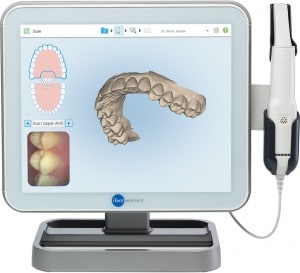What Dental Crowns Are Used for
Dental crowns are versatile and can be used in a wide range of situations. Some of the most common reasons why we use dental crowns are to:
- Restore a heavily decayed tooth
- Preserve a tooth that has been weakened by a large filling
- Build up teeth that are too small or poorly shaped
- Help straighten teeth as part of an instant orthodontic procedure
- Preserve a cracked tooth that has been weakened
- Restore worn teeth
- Restore proper occlusion (tooth contact) and support as part of a TMJ treatment
- Support a dental bridge
Because dental crowns can now be made completely from porcelain, they have become much more common in cosmetic dentistry applications as well as general dentistry ones.
Are All Porcelain Crowns Strong Enough?
We prefer all-porcelain crowns because they are more biocompatible than metal crowns, and they’re more attractive. An all ceramic crown isn’t going to trigger allergies, cause galvanic circuits, or conduct heat and cold into your tooth. And because they look just like natural tooth material, no one needs to know that you’ve got crowns. But one concern people often have is whether their all ceramic crown is going to be strong enough, especially for use on back teeth where bite forces are greatest.
Yes, they are strong enough to take your bite forces. Recent advances in high-tech ceramics have produced materials that are more beautiful and stronger than we could ever have imagined just a decade ago. Now we can recommend porcelain crowns for some of the most strenuous situations in your mouth.
The Dental Crowns Process
Getting dental crowns is a relatively simple process. First we perform a thorough analysis of your tooth. Then we will discuss options to determine whether a crown is the right choice or if you might be better served with less invasive alternatives. If we determine that a dental crown is the best option, we will schedule a time for your procedure.
 At your crown appointment, we will prepare your tooth to receive the crown. This involves removing some tooth material. Then we will take an impression of your prepared tooth. This is quick and simple: we use an iTero digital scanner. This is basically a technomagic wand we wave over your teeth, and it collects a 3D digital impression. We use this impression to design your crown. We send the design digitally to the lab where they will prepare your permanent crown. Meanwhile, you will wear a temporary crown for the week or so that it takes the lab to make a new crown.
At your crown appointment, we will prepare your tooth to receive the crown. This involves removing some tooth material. Then we will take an impression of your prepared tooth. This is quick and simple: we use an iTero digital scanner. This is basically a technomagic wand we wave over your teeth, and it collects a 3D digital impression. We use this impression to design your crown. We send the design digitally to the lab where they will prepare your permanent crown. Meanwhile, you will wear a temporary crown for the week or so that it takes the lab to make a new crown.
When the new crown is ready, we will check it for fit and color. Then we will cement it in place.
Dental Bridges vs. Dental Implants
Bridges are a very good tooth replacement option. Like dental implants, they are fully fixed in your mouth, so they provide you with the ability to chew all your favorite foods. They look highly attractive, too, and most people won’t even know you have a dental bridge.
But there are many reasons why dental implants are better than dental bridges in most situations. Because dental implants are anchored in the bone, they don’t depend on other teeth to support them. Dental bridges, on the other hand, need to be supported by dental crowns over one or two teeth. This means that those teeth have to be modified, and if they’re otherwise healthy teeth, it will weaken them and can cause them to be lost.
Because dental bridges don’t support themselves, they’re limited in where they can be used and how big they can be—we want to avoid excessive force.
Finally, dental bridges don’t go down into the jawbone, so they don’t stimulate the jawbone and the gums. This can lead to a loss of bone and collapse of the gums, which can be unattractive and unhealthy.
If you want to talk to a dentist in Rochester about whether a dental implant or dental bridge is right for you, please call (585) 244-3337 or email us today for an appointment at Contemporary Dentistry.

